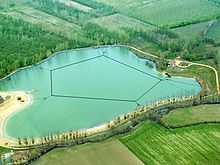Cable skiing

Cable skiing is a way to water ski (or wakeboard), in which the skier's rope and handle are pulled by an electrically-driven cable, whereas traditionally a waterskier is pulled by a motorboat. The mechanism consists of two cables running parallel to one another with carriers between them every 80 metres. The carriers are metal tubes that can hook up tow ropes with riders. Tow ropes are detached and attached at the same time without slowing the system down, which is a main reason for the high efficiency. With a main cable 800 metres long, 10 riders can waterski or wakeboard at the same time. The speed of the main cable can be up to 38 mph (61 km/h), and slalom skiers can reach much higher speeds. The most common speed is 19 mph (31 km/h), which suits wakeboarders best.
The cable is generally suspended 26–30 feet (8–9 metres) above the water. This makes for a different feel than when riding behind a boat, whether wakeboarding or water skiing.
The higher angle of pull makes bigger "air" and sharper turns possible. Generally, on wakeboard-only cables, there are ramps and sliders for the riders to use. Another way for wakeboarders to get air on the cable is to "load the line." Loading the line is putting tension on the rope and using the water as a spring to fling oneself into the air. Though it is possible to do this behind a boat, the higher angle of pull and the slight jerk on the corners allow good riders to get much higher.
Other important advantages of the cable compared to the boat are environmental friendliness and the enormous capacity. The electric motor of the cable is quiet, clean and energy-efficient. A cableway with a main cable 800 metres long operated at 19 mph (31 km/h) makes 38.8 rounds in one hour (456 miles per day if used round the clock) and the users get 19 miles (31 km) of water skiing or wake boarding in that hour.
Cable skiing was invented by the German engineer Bruno Rixen, who built the first water ski cableway on a lake in Bordesholm, Germany, in 1959; Germany has around 70 cables today plus 15 twomast cableways.
Cable skiing is popular in Europe and slowly gaining momentum in the United States. In Germany alone there are over 85 active cables. One spot in Germany, Langenfeld, has four cableway systems and the highest water skiing and wakeboarding capacity in the world. There are five cables in Poland - Margonin (960 m), Szczecinek (1100 m), Ostróda (800 m), Lublin (760 m) and Augustów (740 m). In the U.S. there are 13 cableways.
External links
- A list of all cables and Official Cablewakeboard Federation Homepage
- Cable Park Directory (for iOS)
- Cable Park Directory (for all browsers);
| Wikimedia Commons has media related to Cable skiing. |
